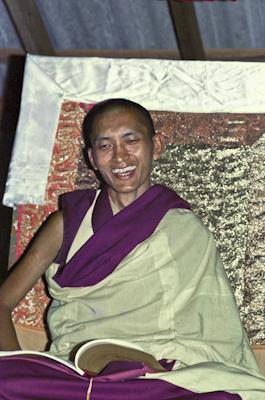The Index Page provides an outline of the topics discussed in each of the lectures. Click on the links below to go directly to a particular lecture.
Lecture 1
- The purpose of the course
- Mind is the source of all suffering
- Only Dharma can cure suffering
- Why we need to check up
- Beginningless mind
Lecture 2
- Mind is the source of suffering
- How the Dharma is the source of happiness
- Introduction to the course
- Pain and fear
- Qualifications of a guru
- Finding a qualified guru
- Marpa and Naropa
Lecture 3
- Qualities of the guru
- Story of Atisha and his guru, Serlingpa
- Qualities of the disciple
- How to practice
- The power of buddha images
Lecture 4
- Shantideva
- Finding a perfect human rebirth
- Teaching and listening to the Dharma
- The existence of other realms
- Karma
- How visualization works
- Meditation on the six realms and the eight freedoms
Lecture 5
- Watching the mind
- Meditation techniques
- The meaning of Guru Shakyamuni Buddha mantra
- How karmic imprints make it easy to learn new things
Lecture 6
- The importance of bodhicitta
- Meditation on the perfect human rebirth
- No difference between ordinary actions of humans and animals
- The purpose of the outlines
- How to practice meditation
Lecture 7
- The evil thought of the worldly dharmas
- We will experience the suffering results of our actions
- Removing the causes of suffering
- Enduring hardships of Dharma practice
- Dharma is the method to cut the cause of suffering
- Checking meditation
Lecture 8
- Bodhicitta brings sublime happiness to sentient beings
- Checking the usefulness of our lives
- Why negative minds are not pure
- Is there a creator God?
- Spiritual and non-spiritual actions defined
- The shortcomings of attachment
- Renouncing the evil thought of the worldly dharmas
Lecture 9
- Karma
- The rarity of a perfect human rebirth
Lecture 10
- The blind turtle
- Meditating on the rarity of the perfect human rebirth
- Overcoming laziness to meditate
- Making this human life meaningful
- Offering food while eating
Lecture 11
- Causes of Guru Shakyamuni Buddha’s holy body
- Our perception is not reliable
- Story of Lekpai Karma
- Need to purify obscurations and collect merit to see the buddhas
- Story of Aredoba
- Story of Sachen Kunga Nyingpo
- We cannot trust our ordinary view
- The mistaken view of self-existent appearance
- Precepts 1
- Motivation
- Ceremony
- Awareness of each precept
- Karmic results of breaking precepts
- Precepts 1
Lecture 12
- The jewel of bodhicitta
- The objects of refuge
- The knowledge of Buddha’s holy speech
- Buddha gives different answers according to our level of mind
- The knowledge of Buddha’s holy mind
- Omniscient mind is everywhere and sees everything all the time
- Story of Kadampa Geshe Ben Gungyal
- “Abandon dirt, abandon smell”
- Precepts 2
- Motivation
- Four immeasurable thoughts
- Precepts 3
- Importance of equanimity
- Equanimity meditation
- Precepts 2
Lecture 13
- We cannot measure the benefits of bodhicitta
- Understanding the objects of refuge
- Knowledge of Buddha’s understanding
- Knowledge of Buddha’s compassion
- Knowledge of Buddha’s power
- Knowledge of Buddha’s actions
- The dharmakaya of transcendental wisdom
- Hinayana, Mahayana and the five paths
Lecture 14
- Knowledge of Dharma
- The five Hinayana and Mahayana paths
- Gross and subtle obscurations
- Ten bhumi
- Knowledge of the lamrim
- Meditating on the qualities of Buddha and Dharma
Lecture 15
- The great benefits of bodhicitta
- Refuge: respecting the Buddha
- How to practice Dharma in everyday life
- How to offer water bowls and other offerings
- The benefits of offering food
- Doing virtuous actions
- How to make water offerings
- Remember the benefits of taking refuge
Lecture 16
- Prayer to receive the blessings of the Triple Gem
- Rinpoche’s mother’s prayers
- Praying for others and leading them in the path of refuge
- The eight major benefits of taking refuge
- The meaning of “inner being”
Lecture 17
- Fighting the worldly dharmas is pure Dharma
- Stories of Geshe Ben Gungyal
- Techniques to overcome attachment to praise and gifts
- Precepts 4
- Motivation
- Four immeasurable thoughts
- Ordination ceremony
- Precepts 4
Lecture 18
- The power of bodhicitta
- Refuge
- Suitable objects of refuge
- Two causes of taking refuge: fear of suffering and trust in the Triple Gem
- Why Buddha, Dharma and Sangha are suitable objects of refuge
- How the maras tried to prevent Buddha’s enlightenment
Lecture 19
- Stories of Guru Shakyamuni Buddha’s power
- Refuge meditation
- Visualization for taking refuge in Buddha, Dharma and Sangha
- Precepts 5 and 6
- Motivation
- Four immeasurables
- Precepts 5 and 6
Lecture 20
- Refuge
Lecture 21
- Read Dharma books not worldly books
- Karma
- Karma is definite
- The results cannot get mixed
- Karma is expandable
- The result of karma is never lost
- How to stop karma
- Confession
- The four opponent powers
Lecture 22
- The eight types of suffering
- The three types of suffering
- Suffering is due to karma and delusions
- What is samsara?
- The six types of suffering
- The twelve links
- Delusions and karma bind us to samsara
- Generating compassion
- How to practice
- Concluding advice
Lecture 23
- Motivation for Tara initiation
- The faults of self-cherishing
- Why the buddhas have become enlightened before us
- The story of Asanga and Maitreya
- Ngagpa Chöpawa and Getsul Tsimbulwa
- All our happiness comes from sentient beings































